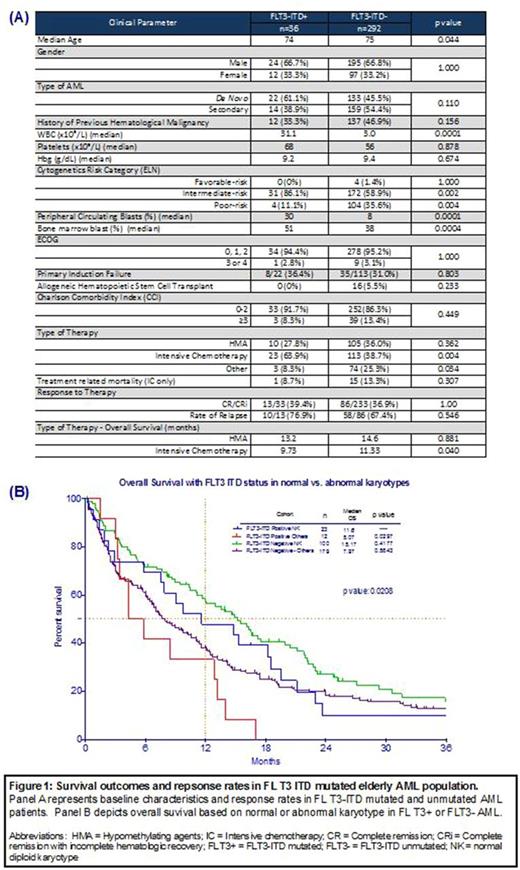Abstract
Introduction
Fms like tyrosine kinase 3 (FLT3)-internal tandem duplications (ITD) mutations are present in 25-30% of patients (pts) with acute myeloid leukemia (AML). Mutated FLT3 (FLT3+) results in dysregulation of myeloid proliferation and is associated with a higher risk a relapse and shortened overall survival. Although presence of FLT3-ITD mutation confers inferior survival in AML with cytogenetically normal karyotype (CN-AML), impact of this prognostic marker in other karyotypes as well as in older AML population is unclear. Thus we aim to further elucidate its impact in such population where biology of the disease is known to be vastly different with limited treatment options and suboptimal outcomes.
Methods
We analyzed a database of 983 AML pts ≥70 years old treated at our institution between 1995 and 2016. Response rates and overall survival (OS) were compared between FLT3+ and unmutated (FLT3-) pts. The Kaplan Meier method was used for survival analysis and the log-rank test was used to determine significance (p-value ≤0.05). The World Health Organization (WHO) criteria were used to define complete response (CR) and complete response with incomplete hematologic recovery (CRi). Categorical data were analyzed by Fisher exact test and all calculated p-values are two-tailed.
Results
Of the 983 pts analyzed, 328 had FLT3-ITD testing at diagnosis. FLT3-ITD mutations were detected in 36 (11%) pts. Baseline characteristics are described in Figure 1A. In the FLT3+ group, 19 pts (61.3%) had normal cytogenetics (CN-AML) compared to 73 (39.5%) in the FLT3- cohort. There was lower rate of poor-risk cytogenetics by European LeukemiaNet (ELN) criteria in FLT3+ cohort compared to FLT3- (11.1% vs. 35.6%, p=0.004). FLT3+ cohort had higher median WBC (31.1x109/L vs. 3x109/L, p=0.0001), higher median peripheral blood circulating blasts (30% vs. 8%, p=0.0001) and higher median bone marrow blasts (51% vs. 38%, p=0.0004).
No significant difference was noted in OS between FLT3+ and FLT3- pts (9.4mos vs 10.1mos, p=0.452). FLT3 status did not impact the rate of CR/CRi (39.4% vs. 36.9%, p=1.00) regardless of the type of therapy. Intensive chemotherapy was used frontline with higher frequently than other treatment modality in FLT3+ cohort (63.9% vs. 38.7%, p=0.004) however median OS between IC treated FLT3+ and FLT3- was inferior in FLT3+ cohort (9.7 vs. 11.3mo, HR 1.76, 95% CI 1.03-3.03, p=0.040). Furthermore, in the FLT3+ cohort, no significant difference in OS was noted between HMA (13.2mos) and IC (9.7mos) treatments (p=0.108).
We further assessed effect of FLT3-ITD in various cytogenetic groups which is represented in Figure 1B. In CN-AML patients, there was no OS difference noted between FLT3+ and FLT3- cohorts (11.6 vs. 15.2mo, p=0.4177). The OS between CN-AML pts (15.2mo) and AML cohort with abnormal cytogenetics (12.4mo), irrespective of FLT3 status, was not statistically significant (p = 0.483). However, FLT3+ status combined with abnormal cytogenetics resulted in significantly reduced OS compared to FLT3+ CN-AML (5.1 vs. 11.6, HR 2.65, 95% CI 1.101-6.399, p=0.030). Furthermore, FLT3+ combined with abnormal cytogenetics cohort also had inferior outcome when compared to FLT3- cohort harboring abnormal karyotype (5.1 vs. 15.2mo, HR 4.67, 95% CI 1.85-11.61, p=0.001).
Conclusion
Although FLT3+ AML presents with higher WBC, bone marrow and peripheral blood circulating blasts compared to FLT3- AML, our data suggests that isolated FLT3-ITD mutation status does not have prognostic impact in AML patients age ≥70 years. Interestingly, FLT3-ITD mutation status in CN-AML was not prognostic but when combined with abnormal cytogenetics, FLT3+ subgroup had significantly inferior survival compared to FLT3- subgroup. Although more patients received intensive chemotherapy in FLT3+ cohort, rate of CR+CRi were equivalent with achievement of inferior survival outcome compared to FLT3- cohort and at least equivalent outcome compared to HMA treated FLT3+ cohort. The number of FLT3+ pts in this study is small and these results need to be validated in a larger dataset.
Sallman: Celgene: Research Funding. Padron: Incyte: Honoraria, Research Funding. Komrokji: Novartis: Honoraria, Speakers Bureau; Celgene: Honoraria. Lancet: BioSight: Consultancy; Jazz Pharmaceuticals: Consultancy; Bio-Path Holdings: Consultancy; Janssen: Consultancy; Celgene: Consultancy; Erytech: Consultancy; Boehringer Ingelheim: Consultancy; Novartis: Consultancy; Pfizer: Other: Institutional research funding, Research Funding. Sweet: Ariad: Consultancy, Speakers Bureau; Incyte: Research Funding; Novartis Pharmaceuticals: Consultancy, Speakers Bureau; Pfizer: Consultancy; Karyopharm: Consultancy, Research Funding; Otsuka: Consultancy.
Author notes
Asterisk with author names denotes non-ASH members.


